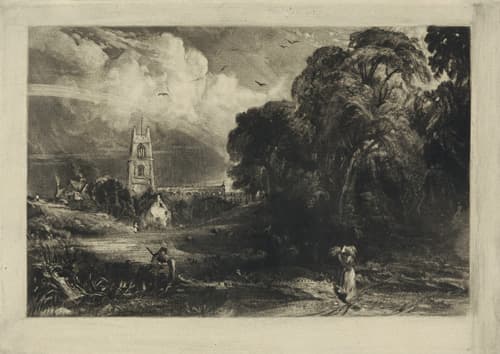
Biography
John Constable was a landscape painter born at East Bergholt in Suffolk in 1776. He was, with Turner (q.v.) the major English landscape painter of the 19th century. Although he started exhibiting at the Royal Academy in 1802 it was not until 1819 that he was finally recognised by the Academy. In his own words the Suffolk countryside made him a painter and he was happiest at painting watermills and windy skies, a love he owes to his upbringing as the son of a miller. His success in France influenced the development of artistic movements such as the Barbizon School and Romantic artists such as Eugene Delacroix. He was the last great painter of the Dutch landscape tradition. A large collection of his works was donated to the V&A by his daughter and Christchurch Mansion in Ipswich Suffolk has the greatest number of his paintings outside London.
Statement
This drawing was executed during one of the most emotional periods of Constable’s life. 1816 marks the death, in May, of his father. His mother had died the previous year. During the winter of 1815 and the following spring and summer, while staying in Suffolk to care for his father, Constable had, as in previous years, painted his favourite places, but perhaps this time with a tinge of sadness and nostalgia although it is not evident here.
Constable could often be seen walking the countryside, making studies of the landscape around where he lived. He painted many mills, including Flatford Mill the same year, in 1816 and later, in 1821, he would talk about his love of such places which reminded him of his ‘careless boyhood’: ‘The sound of water escaping from Mill dams, so do Willows, Old rotten Banks, slimy posts, & brickwork. I love such things […] as long as I do paint I shall never cease to paint such Places. They have always been my delight.’ [1821 (VI: 7-8)]
Constable admired nature and was amazed by the lack of knowledge of most people as far as the natural world surrounding them was concerned. Consequently in 1836 twenty years after this drawing, when he was more established, he felt his duty to give a series of lectures on the history of landscape painting as a basis for his theories. This series of six critical lectures which was delivered to the Royal Institution of Great Britain in 1836 focused on three aspects of landscape painting, including the scientific knowledge on which painting should be based. Painting is a science, and should be pursued as an inquiry into the laws of nature. Constable was a naturalist who made an innumerable number of studies of clouds mainly painted in oil on paper. Each was inscribed in detail with a date, a time and the weather conditions. They became a sort of diary and more importantly they helped the artist to express his emotions. In a letter in 1821 the artist described the sky as ‘the keynote…the chief organ of sentiment’. Interestingly he seemed to have preferred rough or stormy weather.
Bibliography
- LESLIE, C.R., Memoirs of the Life of John Constable, R.A. London, 1843
- REYNOLDS, G., Catalogue Resume of the Constable Collection, Victoria and Albert Museum, London, 1959
- TAYLOR, Basil, Constable, Paintings, Drawings and Watercolours, Phaidon, London, 1973
Evelyne Bell







